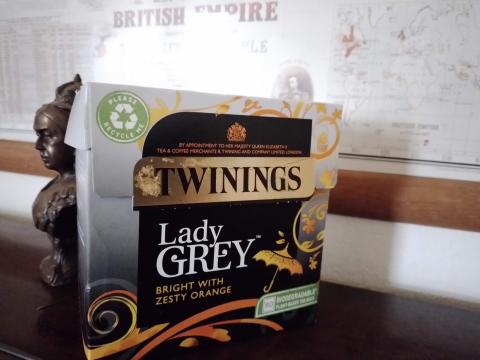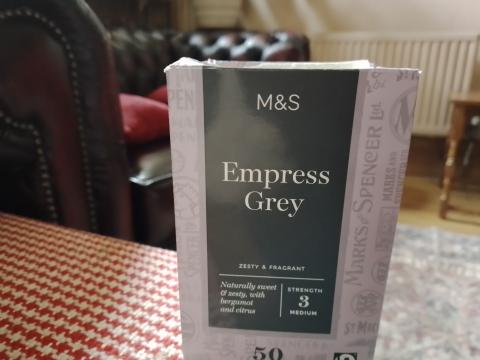Teas Lady Grey & Empress Grey

Not dissimilar in name or flavour to Earl Grey tea is Lady Grey, named after the noble gentleman's wife. Black tea with Earl’s bergamot oil, it has also dried peel of oranges and lemons added to the mix. This apparently reduces the bergamot’s potency, and makes it a more agreeable beverage to those tea drinkers, especially in Scandinavia, who found the Earl overpowering. Whereas Earl Grey is an early nineteenth-century tea, Lady Grey is a late twentieth-century brew, its aristocratic name asserting its similarity in taste and price to the older, more established blend. It is not an unpleasant quaff, but one must be ‘in the mood’ for it. Even I refrain from the addition of milk, enjoying its lighter flavour in just hot water.
As Lady Grey is a trade mark belonging to Twining’s of London, rival tea merchants and manufacturers have had to come up with their own names for their similar blends. Thus Marks and Spencer and Unreval Tea offer an Empress Grey, the blend of which tastes remarkably similar to Twining’s Lady Grey. The Pekoe Tea Company of Edinburgh makes a ‘citrus Earl Grey luxury blend’ which it is pleased to market as Duchess Grey, while Madame Flavour of Australia produces the slightly more egalitarian-sounding Madam Grey. The Tea Makers of London company dispenses with honorific titles altogether and calls its ‘aromatic, fruity, scattered with golden marigold flowers’ blend plain Mary Grey.
Quite what Mary Ponsonby of Whitehaven, Cumberland, who married Earl Grey, would have thought of all this, one cannot say. The wife of an earl is styled a countess (the continental equivalent of an earl being a count); she was not a duchess, much less an empress. Few would have addressed her as ‘Mary’ save her parents and husband, while 'Madam Grey' would have been an unusual mode of address even on the Continent. 'Lady Grey' would be the most usual way of speaking to a countess. I suspect that our tea merchants are playing fast and loose with established and venerable traditions of aristocratic hierarchy!

Teas aside (and being an owner of a box of Lady and Empress Grey, I can vouch for their almost indistinguishable flavour), I look with interest at how the Lord Jesus is honoured and addressed throughout recent church history. In the sixteenth and seventeenth centuries, He was (rightly) depicted in sermons as king, lord, judge, and conqueror. From the late Victorian era, He was (rightly) depicted as friend, helper, brother and carer. These reflect their respective societies, yet the Bible teaches both. He is simultaneously Saviour and Judge, Shepherd and Slaughterman, Brother and King, Lamb and Lion. I suspect that our own, present culture’s fixation on equality and approachability means we need greater reminder of Christ’s pre-eminence, glory, power and majesty, much as early-modern pulpits would have done better to elucidate His role as caring friend and amorous lover. Let us meditate upon the whole counsel of God, believing and accepting the wide variety of the Lord Jesus’ offices, titles and ministries, and not merely reflecting the times in which we live, nor the fulfilments of our own, personal needs. Those who refer to Him as 'Big J' need, among other things, a strong dose of the Bible. Let the tea merchants of the world blend what they will and call it what they like; may we bend the knee to our rightful King and Emperor, while accepting His gentle embrace as our closest, dearest friend and most trusted confidant.
...and they shall call his name Emmanuel, which being interpreted is, God with us.
- Log in to post comments


 Sunday Worship 10.45am & 6.00pm
Sunday Worship 10.45am & 6.00pm